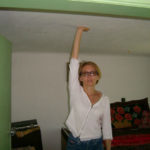These are trees, but most often bushes planted in one row. Harmoniously fitting into the general view of the garden, they replace a fence or fence. In addition, a hedge is also a structure that protects the site from the winds and prying eyes of its neighbors. This is a picturesque element of the decorative design of the site itself, designed to emphasize the beauty and originality of some plants. She plays a large role in dividing the garden into zones.

At the same time, it provides shelter for small animals, birds and insects. And this, in turn, has a beneficial effect on the creation of a special microclimate in the garden itself.

Create a hedge
Before you begin the construction of hedges, you should consider a plan for future work. After all, the process itself will require you not only a huge amount of time, but also a lot of patience: it will take several years to form it.
First of all, if there is a need for this, the issue with openings, columns and alleys remains to be solved.
In addition, when planting a hedge, we must remember that some types of trees, growing, can obscure the sun with their crowns.
To prevent this from happening, you should opt for climbing vines or deciduous trees with an evergreen shrub below. In summer, they will provide the garden with the necessary shade, and in winter they will be free to let in the warmth of sunlight, keeping the "secret" life of their owners secret.

Depending on what role the hedge will play in landscape design, both its height and the types of plants that it will consist of are selected. After all, not all plants are able to get along with each other. So, for example, birch has a depressing effect on the pine, so gardeners do not advise planting seedlings of these trees in one row. Most often, in mixed hedges, fruit bushes and trees are found.

Speaking about the benefits, beauty and low cost of living fences, it is worth noting their only drawback: the depletion of the soil. Therefore, without the "bait" of the soil under hedges and nearby growing plants simply can not do.

Varieties of live fencing
The hedge is divided into three main groups: the external living wall, the actual hedge, and the low curb. The height of the first should be more than two meters. The height of the remaining hedges must be carefully monitored. Medium or actually live can be from a meter to two. The curb cannot be higher than a meter and below 0.5 m.
Moreover, they can be mixed or single pedigree, free or have a shape, grow both in a row and in several rows (most often in two rows), can be soft or prickly.


Creating a hedge, preference is given to shade-tolerant plants. Evergreen plants that tolerate a haircut are also in demand. Without requiring special care, they do not take up much space.

Given the diversity of the Russian climate, gardeners give preference to conifers and deciduous bushes. The walls of thuja, ordinary spruce, Forsythia and Barberry of Thunberg will look very bright and unusual on the site.

-
 Features of the design of the garden gazebo
Features of the design of the garden gazebo
-
 How to choose the best TV stand
How to choose the best TV stand
-
 What should be a modern countertop
What should be a modern countertop
-
 Low ceilings - what to do
Low ceilings - what to do
-
 Why do I need a swing mechanism in an office chair
Why do I need a swing mechanism in an office chair
-
 How to choose furniture for an elderly person
How to choose furniture for an elderly person
-
 The choice of furniture for a country house
The choice of furniture for a country house
-
 How to choose a desk for a student
How to choose a desk for a student
-
 What bed to choose for a healthy sleep
What bed to choose for a healthy sleep
-
 The advantages of solid wood furniture
The advantages of solid wood furniture
-
 Original and roomy bookcase
Original and roomy bookcase
-
 Pine bed - hit of the season
Pine bed - hit of the season
New publications are published daily on our channel in Yandex. Zen
Go to Yandex. Zen


